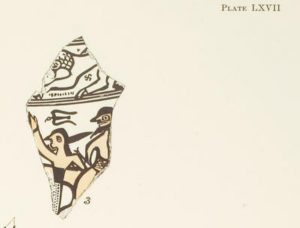Chapter 13: Herakles
Previous Page Table of Contents Next Page
♠ ApB 2.7.6 – Apollodoros, Library
Being at the point of death, Nessus called Deianira to him and said that if she would have a love charm to operate on Hercules she should mix the seed he had dropped on the ground with the blood that flowed from the wound inflicted by the barb. She did so and kept it by her. Greek Text
♠ DS 4.36.5 – Diodoros Siculus, Library of History
He urged her, accordingly, to take the seed which had fallen from him and, mixing it with olive oil and the blood which was dripping from the barb of the arrow, to anoint with this the shirt of Heracles. This counsel, then, Nessus gave Deïaneira and at once breathed his last. And she put the seed, as Nessus had enjoined upon her, into a jar and dipped in it the barb of the arrow and kept it all unknown to Heracles. Greek Text
♠ Met 9.1-100 – Ovid, Metamorphoses
HERCULES AND ACHELOUS
To him the hero, who proclaimed himself
a favored son of Neptune, answered now;
“Declare the reason of your heavy sighs,
and how your horn was broken?” And at once
the Calydonian River-God replied,
binding with reeds his unadorned rough locks:
“It is a mournful task you have required,
for who can wish to tell his own disgrace?
But truly I shall speak without disguise,
for my defeat, if rightly understood,
should be my glory.—Even to have fought
in battle with a hero of such might,
affords me consolation.
“Deianira
(you may have heard some tales of her) was once
the envied hope of many. She was then
a lovely virgin.—I, among the rest
who loved this maiden, entered the fair home
of her great father Oeneus, and I said;
“ ‘Consider all my claims, Parthaon’s son,
for I am come to plead your daughter’s cause
and mine—So you may make me son-in-law.,—’
no sooner was it said, than Hercules
in such words also claimed the virgin’s hand:
all others quickly yielded to our claims.
“He boasted his descent from Jupiter;
the glory of his labors and great deeds
performed at his unjust stepmother’s wish.
“But as he was not then a God, it seemed
disgraceful if my state should yield my right;
so I contended with these haughty words,
‘Why should this alien of a foreign land,
contending for your daughter, match himself
to me! king of the waters in this realm!
For as I wind around, across your lands,
I must be of your people, and a part
of your great state. Oh, let it not be said,
because the jealous Juno had no thought
to punish me by labors, my descent
is not so regal! This tremendous boast,
that you, Alcmena’s son, are sprung from Jove,
falls at the touch of truth;—or it reveals
the shame of a weak mother, who so gained
your doubtful glory of descent from Heaven!
Prove your descent from Jupiter is false,
or else confess you are the son of shame!’ Continue Reading Latin Text
♠ ApB 2.7.5 – Aollodoros, Bibliotheke (Library)
And having come to Calydon, Hercules wooed Deianira, daughter of Oeneus. He wrestled for her hand with Achelous, who assumed the likeness of a bull; but Hercules broke off one of his horns. So Hercules married Deianira, but Achelous recovered the horn by giving the horn of Amalthea in its stead. Now Amalthea was a daughter of Haemonius, and she had a bull’s horn, which, according to Pherecydes, had the power of supplying meat or drink in abundance, whatever one might wish. Greek Text
Brussels, Musee d’Art et d’Histoire A 1374. Corinthian kotyle, Herakles, Acheloos (?)
New York, Metropolitan Museum 59.64. Attic. Herakles, Acheloos.
Boston, Museum of Fine Arts 99.519. Attic kylix, Herakles, Acheloos.

♠ Paus 3.18.16 – Pausanias, Description of Greece
There are also represented the wrestling of Heracles with Achelous... Greek Text
♠ Paus 6.19.12 – Pausanias, Description of Greece
The Megarians who are neighbors of Attica built a treasury and dedicated in it offerings, small cedar-wood figures inlaid with gold, representing the fight of Heracles with Achelous. The figures include Zeus, Deianeira, Achelous, Heracles, and Ares helping Achelous. There once stood here an image of Athena, as being an ally of Heracles, but it now stands by the Hesperides in the Heraeum. Greek Text
Munich Muenzsammlung A1293. Seal. Centaur and female figure.
New York, Metropolitan Museum 17.190.2072. Bronze group. Herakles and Centaur.

New York, Metropolitan Museum 11.210.1. Protoattic amphora by the New York Nessos Paint. Herakles, Nessos (to l.).

Metropolitan Museum collection
Athens, National Museum from the Argive Heraion. Stand, woman and centaur.

Previous Page Table of Contents Next Page
Artistic sources edited by R. Ross Holloway, Elisha Benjamin Andrews Professor Emeritus, Joukowsky Institute for Archaeology and the Ancient World, Brown Univ., and Frances Van Keuren, Prof. Emerita, Lamar Dodd School of Art, Univ. of Georgia, September, 2017.
Literary sources edited by Elena Bianchelli, Retired Senior Lecturer of Classical Languages and Culture, Univ. of Georgia, November 2023.
956 total views, 1 views today